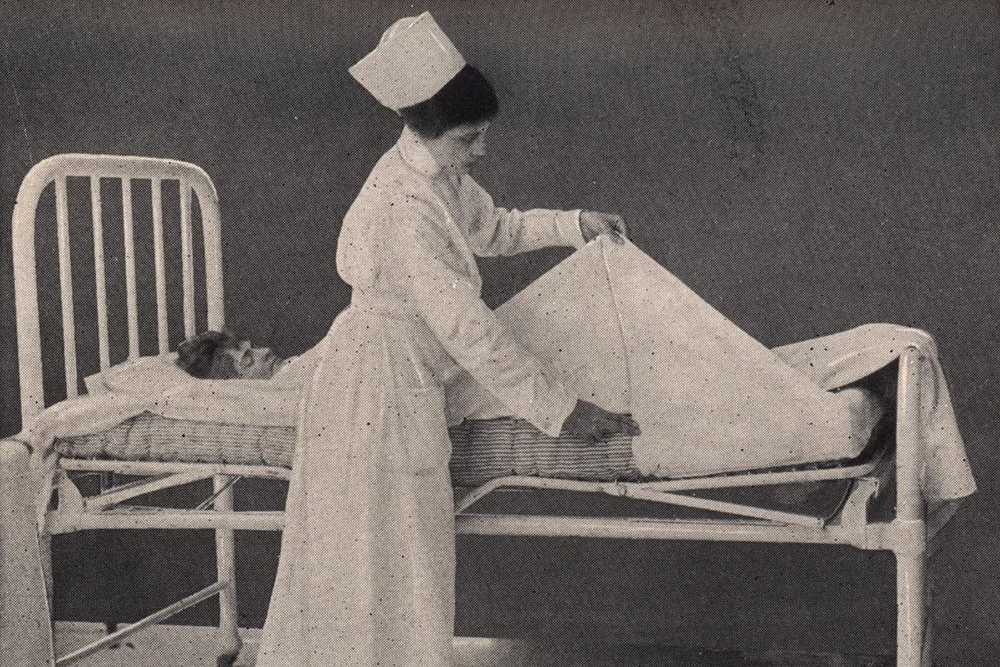Flashback Friday - The Art of Bed Making

Rest is critical to patients’ recovery—precisely why proper bedmaking skills have been a consistent part of nursing education and practice. Without the benefit of plastic mattress covers, adjustable beds, antibacterial cleansers, and industrial laundry services, early nurses had their work cut out for them.
“In preparing a bed for a patient, whether in the hospital or the home, we are not merely preparing it for eight hours of sleep, a period of comparatively little activity, but for the entire twenty-four hours during which all normal activities must be carried on.”
Hester K. Frederick and Ethel Northam in their 1941 TEXTBOOK OF NURSING PRACTICE
Historically, nursing students were taught three styles of bedmaking: “open beds” (those about to be occupied by a patient), “closed beds” (unoccupied beds covered with a top sheet to keep dust and dirt away), and how to make beds with patients in them. “Anesthesia bedmaking”—a type of open bedmaking—was designed with post-surgical patients in mind: no pillow or top sheet, a bath towel at the head of the bed, and a warm water bottle or warm bricks wrapped in towels atop the draw sheet, covered by a blanket.







Given that a full day in bed involves lots of activity—eating, drinking, breastfeeding, bathing, toileting—sheets can easily become soiled, twisted, and uncomfortable. Mattresses (preferably firm, and horsehair, not feather) needed to be protected. In addition to being untidy, bed sheet wrinkles and mattress lumps could cause bed sores, which could spur infection.
Redundant layers were key. The first step usually involved an initial protective layer over the mattress (sometimes a rubber pad or length of oilcloth) before a second protective length of sheet was girdled thickly across the bed’s middle where a patient’s thighs and buttocks would rest. Next came long, rectangular under sheets centered on the bed and stretched tightly, their ends tucked deep under the mattress to its center so the patient’s weight kept them from shifting. Under sheets’ sides were fashioned into “hospital corners”: a mitered edge folded sharply like an envelope and carefully and tightly tucked underneath the mattress sides. For particularly restless patients, sometimes under sheets were pinned to mattresses to keep them in place.
"The bed must look neat, and, in a ward, all the beds should look uniform because uniformity is necessary for a neat appearance, and the maintaining of a neat appearance is an essential element in promoting cleanliness.”
Maxwell and Pope, 1923, PRACTICAL NURSING: A TEXT-BOOK FOR NURSES
Atop these three layers came the “draw sheet,” so called because of its design to be drawn, or slid, from one side to the other to provide bedbound patients a cool spot on which to lie. Draw sheets were placed only slightly more loosely on the mattress to allow for straightening and tightening under a patient’s body; their ends and edges could also be mitered under the mattress to keep them securely in place.
Next up was the top sheet (“hem wrong side up,” advised Anna Caroline Maxwell and Amy Elizabeth Pope in their 1923 Practical Nursing: A Text-Book for Nurses), “so that the right side will be uppermost when the sheet is turned over the blanket”) which extended three inches beyond the top rim of the mattress and was tucked under at the bed’s foot-end. Then came blankets (“All wool or at least 80% wool,” Pope and Maxwell advised), fashioned akin to the top sheet.
For bedmaking around bedridden patients, nurses were taught to gently shift patients to the bed’s side, buttress them with pillows, and slowly toggle the soiled sheets off towards the bed’s center to be replaced with fresh ones. Heavy patients were maneuvered by cradling them in loosened draw sheets. The process, which nurses were advised to do in teams, must have taken a great deal of time, especially to novices.
In their Textbook of the Principles and Practice of Nursing, Bertha Harmer, RN, AM, and Virginia Henderson, RN, AM, caution against too tight bedding, implicated in patients’ discomfort and a deformity called “foot drop.” Harmer and Henderson recommended that nurses make a center-of-the-mattress pleat from the foot of the bed to ease movement below-the-sheets.
It wasn’t until 1957 that the first fitted sheet made its debut. Bertha Berman, who patented it, outfitted a draw sheet edged with elastic garters to keep it well-placed on the bed. By 1960, Harmer and Henderson noted these “contour sheets” in their textbook that replaced rectangular draw sheets thanks to their “manufactured mitered corners,” which “[eliminated] the problem of getting a lastingly smooth lower sheet.”
By 1992, Canadian Gisele Jubinville went one step further when she patented fitted sheets with deep corner pockets that grab mattresses securely. The following year, Jubinville sold her patent for a cool million dollars. Now if we could just figure out how to fold them.
###
Today’s #Flashback Friday brought to you by the Bjoring Center for Nursing Historical Inquiry, one of just three nursing history archives in the world.
